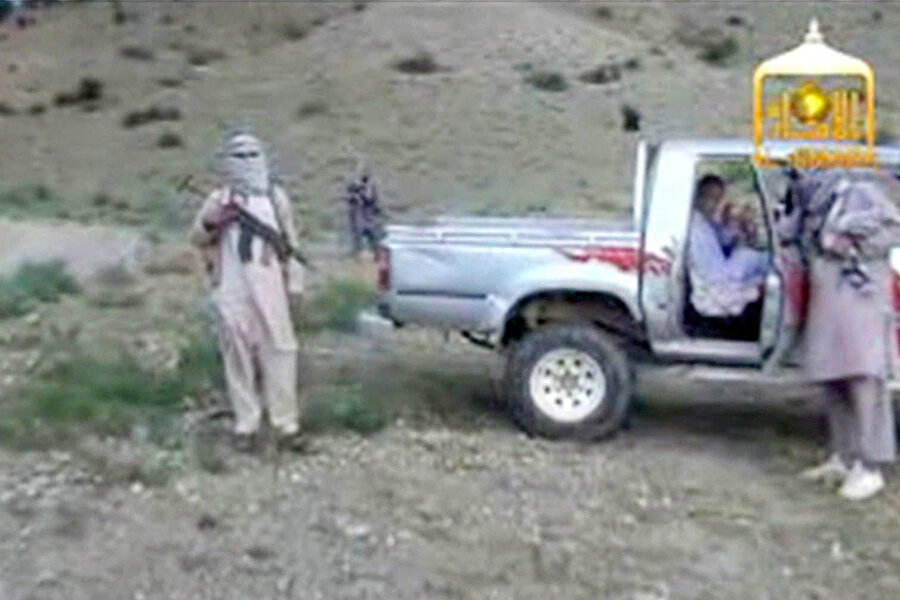Bowe Bergdahl deal: Who are Taliban 5 and how dangerous are they?
Loading...
| Washington
The release of five Taliban figures from the US detention camp at Guantánamo Bay, in exchange for Sgt. Bowe Bergdahl, may come back to bite the US – or not, say analysts, whose assessments of the five and the threats they now pose are mixed.
Some South Asia and Middle East security analysts expect the Taliban Five will probably return in some capacity to the fight in Afghanistan – perhaps even with enhanced “street cred.” Others, though, predict they may find it hard to fit back in, given how much Afghanistan has changed since the Taliban regime was deposed in 2001.
The five men, held in US custody for more than a decade, almost certainly harbor deep anger toward the US, most agree. But that doesn’t mean they have adopted international jihad and will dedicate themselves to attacking Americans and the US, some experts say.
“They’ll be angry at the US, but I don’t know that that’s going to make them supportive of overseas attacks or that the anger translates into supporting global jihad,” says Seth Jones, associate director of RAND Corp.’s International Security and Defense Policy Center in Washington. “The Taliban remain pretty parochial,” adds the Afghanistan and Pakistan expert, “and pretty focused on Afghanistan and defeating the Karzai government.”
Released Saturday to Qatari officials, the five were all officials in the Taliban government that had harbored Al Qaeda in Afghanistan. But they are not all equal, analysts say.
“The five are certainly all high-profile, but they had varying levels of importance,” says Marvin Weinbaum, a former State Department analyst with close knowledge of US-Taliban negotiations. “Only two of them were really field types, while the other three were what I’d call ‘administrative types,’ for lack of a better word,” adds Mr. Weinbaum, now at the Middle East Institute in Washington.
RAND’s Mr. Jones divides the five into two groups: three “senior officials” with the Taliban, and a “second tier” of lesser officials but “still important” players.
The three “senior officials":
Khair Ulla Said Wali Khairkhwa. He served as interior minister in the Taliban government and was a governor of Herat Province. The US believes he had direct dealings with Al Qaeda leader Osama bin Laden. He had been held at Guantánamo since 2002.
Mullah Mohammad Fazl. As Army chief of staff under the Taliban regime and as a deputy defense minister, he allegedly directed the massacre of thousands of Afghan Shiites. He was a senior commander of Taliban combat operations against the Northern Alliance. He arrived at Guantánamo in late 2001, one of the first detainees there.
Abdul Haq Wasiq. He was deputy chief of the Taliban intelligence service, serving under a cousin who was intelligence director.
The two “second-tier” officials:
Mullah Norullah Noori. He was the Taliban's governor of Balkh Province and a coordinator of the fight against the Northern Alliance. Classified military files divulged by WikiLeaks describe him as “one of the most significant former Taliban officials” at Guantánamo and as responsible with Mr. Fazl for the killings of Shiites.
Mohammad Nabi Omari. He was the Taliban’s communications director and a provincial official in Khost. Described in the WikiLeaks files as having strong ties to anti-coalition militias, he helped organize the escape of Al Qaeda officials to Pakistan in late 2001.
Under terms of the exchange deal, the five Taliban are to remain in Qatar for a year, with the Qatari government pledging to ensure that they do not leave the tiny emirate.
But some in Congress say they assume that the five Taliban will eventually return to Afghanistan to continue the fight. “It is highly likely that they will return to the fight against our country after their year in Qatar, which is why I share concerns expressed by many members of both parties about the administration’s decision,” Sen. Susan Collins (R) of Maine said Wednesday after a closed-door administration briefing on the swap.
Experience suggests such concerns have merit. In 2007, a former senior Taliban official, Mullah Abdul Qayyum Zakir, was released from Guantánamo – only to return to Afghanistan to become the Taliban’s director of military operations.
Such examples lead RAND’s Jones to figure that the five released detainees will have enhanced “street cred” within the Taliban for having spent “more than a decade in the belly of the beast” at Guantánamo Bay. “There’s no question some of these individuals have the ability to play a major role” in the Taliban leadership, he says.
Still, the war in Afghanistan is very different now than it was more than a decade ago, when the five were sent to Guantánamo, analysts also note. The US is no longer involved in combat operations and by next year its troops will number fewer than 10,000, for training Afghan security forces and limited counterterrorism operations. Under President Obama’s plan, the US military will largely be out of Afghanistan by the end of 2016.
Someone like Fazl, the former Army chief of staff during the Taliban regime, could presumably provide a “boost” to a Taliban “that has struggled in a few provinces like Kandahar" and that faces a modernized Afghan Army, says Jones.
But Weinbaum says he doubts that the five will find major roles in a different Taliban fighting a different war. “Their real value will be the propaganda boost their release provides, but after that things are less clear,” he says. “They’ve been out of the loop for so long and [the Taliban] have undergone so many internal changes, it’s hard to see where or how they’ll fit in now.”






